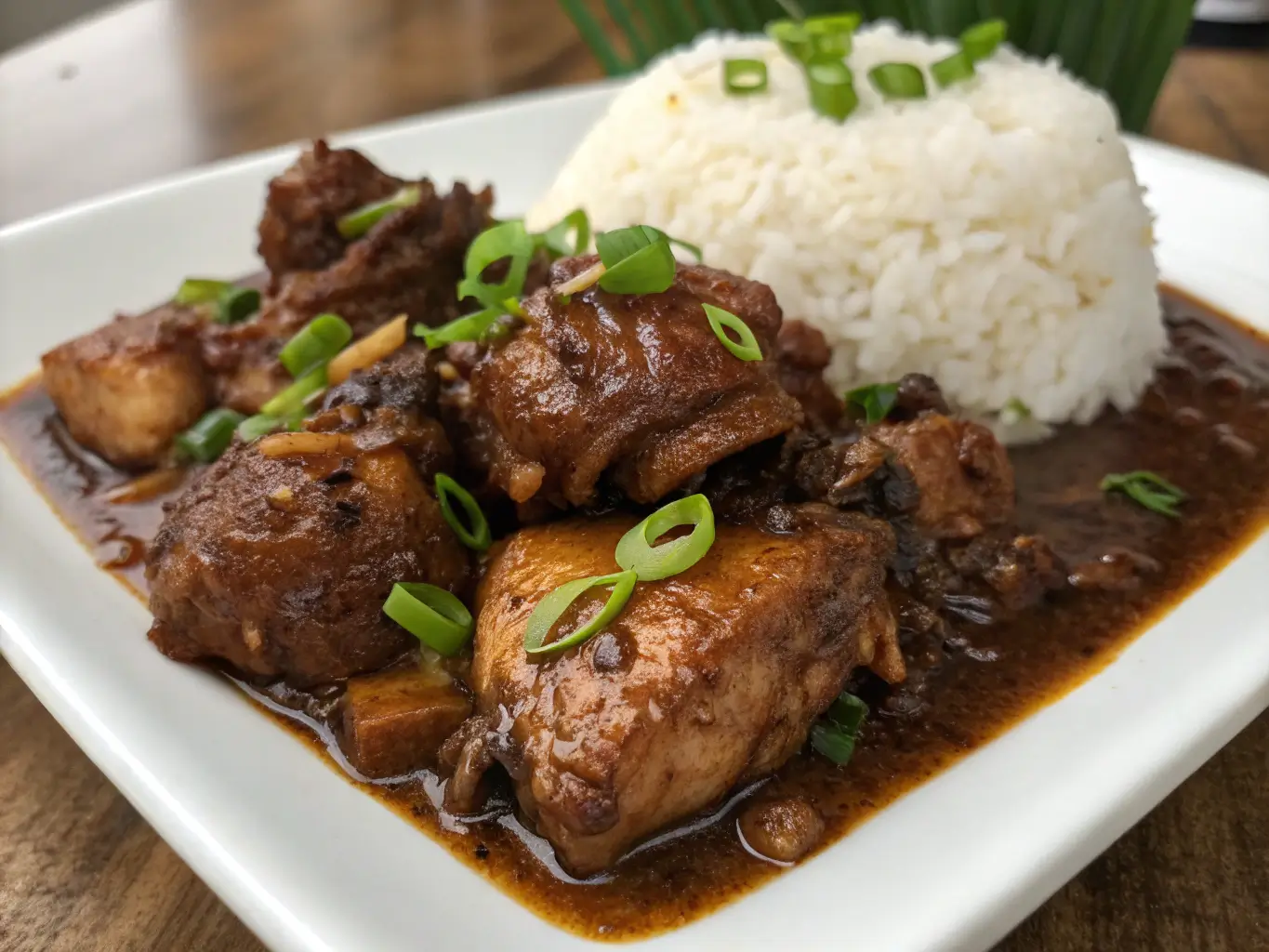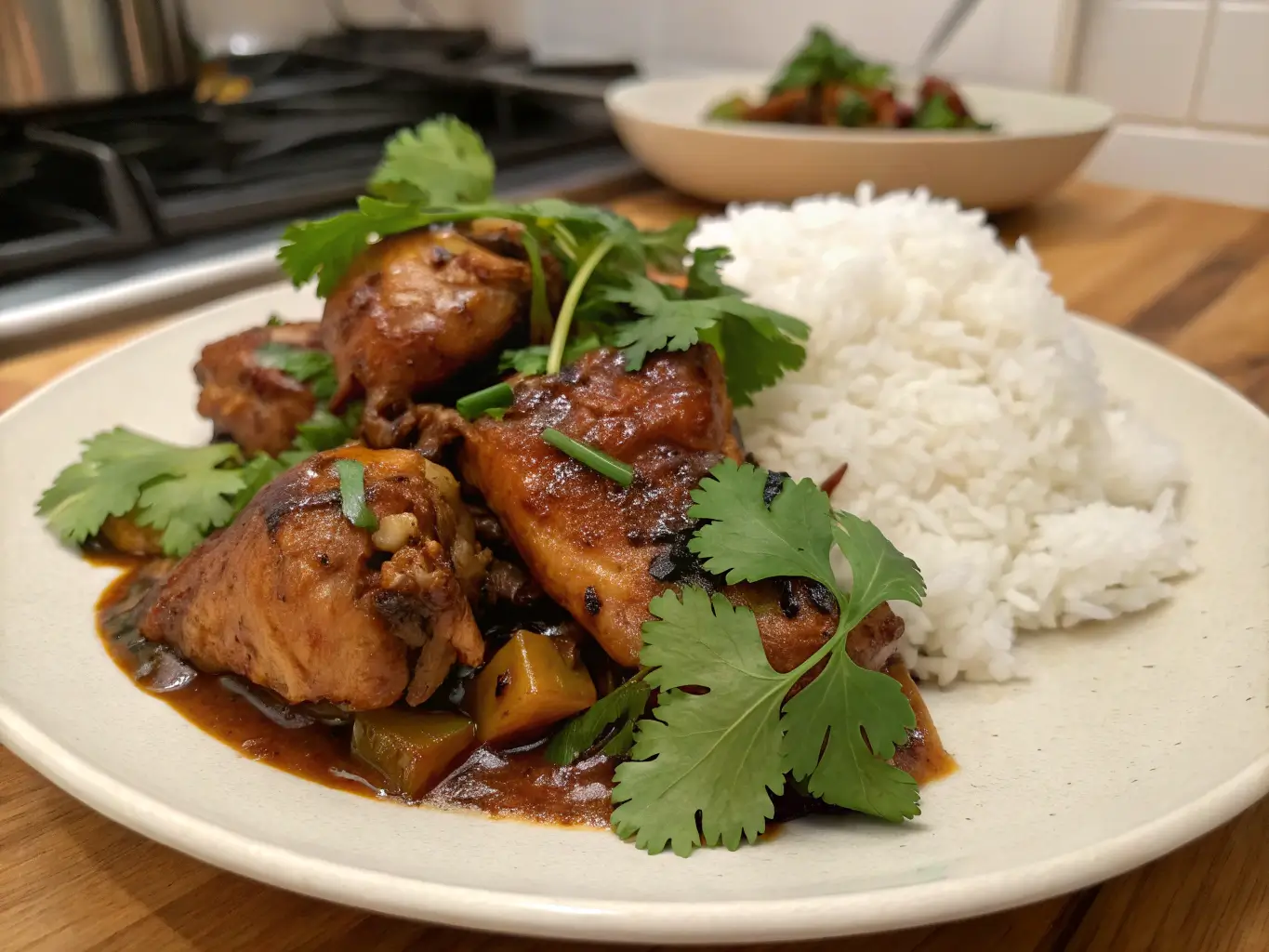Filipino Adobo Chicken: The Ultimate Guide to a Flavor-Packed Classic
Filipino Chicken Adobo isn’t just a meal—it’s a cultural experience. As the Philippines’ most iconic dish, it represents the perfect harmony of tangy, savory, and garlicky flavors, all simmered to perfection in one pot. Whether you’re a busy home cook or an adventurous foodie, this foolproof, pantry-friendly recipe delivers maximum taste with minimal effort.
What Makes This Adobo Recipe Special?
Authentic yet adaptable – Stays true to tradition while allowing for personal twists.
One-pot wonder – Less cleanup, more time to enjoy your meal.
Meal-prep champion – The flavors deepen beautifully overnight.
Budget-friendly – Uses simple, affordable ingredients.
In this comprehensive guide, we’ll walk you through everything—from the dish’s fascinating origins to pro tips for the most succulent, flavorful Adobo imaginable.

The Rich History of Filipino Adobo
Adobo’s story begins long before Spanish colonization. Indigenous Filipinos used vinegar and salt as natural preservatives for meat, creating an early version of this dish. When Spanish settlers arrived in the 16th century, they named it “adobo” after their own marinated dishes, but the Filipino version remained distinct—less oily, more tangy, and deeply aromatic.
Fun Fact:
- Adobo is so beloved that it was almost declared the Philippines’ national dish (though it remains an unofficial favorite).
- Every region has its own twist—some add coconut milk (Adobo sa Gata), while others prefer a dry, crispy version (Adobong Puti).
This recipe stays true to the classic soy-vinegar balance, with tips to customize it your way.
Why This Recipe Works (The Science of Flavor)
Adobo’s magic lies in its perfect equilibrium of five key elements:
- Umami – From soy sauce and slow-cooked chicken.
- Acidity – Vinegar tenderizes the meat and adds brightness.
- Aromatics – Garlic and peppercorns create depth.
- Subtle sweetness – A pinch of sugar rounds out the tang.
- Silky texture – Reduced sauce clings to every bite.
Unlike stews that rely on heavy cream or wine, Adobo gets its richness from reduction and caramelization, making it lighter yet intensely flavorful.
Ingredients & Equipment (The Key to Success)
For the Chicken Adobo (Serves 4–6)
Core Ingredients
- 2.5 lbs (1.1 kg) chicken thighs and drumsticks (bone-in, skin-on for juiciness)
- ¾ cup (180ml) soy sauce (low-sodium recommended)
- ¾ cup (180ml) cane vinegar (or white vinegar in a pinch)
- 1.5 cups (360ml) water
- 10–12 garlic cloves, smashed (yes, it’s a lot—trust us!)
- 1 tbsp whole black peppercorns (or 1.5 tsp ground pepper)
- 4–5 dried bay leaves (fresh works too)
- 1 tbsp brown sugar (optional, but balances acidity)
Optional Flavor Boosters
- 1 large onion, sliced into rings
- 2–3 Thai chilies (for heat)
- 1 tsp annatto powder (for color)
- 1 stalk lemongrass, bruised (adds citrusy aroma)
Equipment You’ll Need
- Dutch oven or heavy-bottomed pot (even heat distribution)
- Tongs (for flipping chicken)
- Fine-mesh strainer (optional, for removing peppercorns)
Step-by-Step Instructions (With Pro Techniques)
1. Marinate for Maximum Flavor (30 mins–Overnight)
- In a large bowl, combine chicken, ½ of the soy sauce, half the garlic, and peppercorns.
- Cover and refrigerate for at least 30 minutes (overnight for deeper flavor penetration).
Pro Tip: If short on time, skip marinating—the simmering process infuses plenty of flavor.
2. Sear the Chicken (5–7 mins)
- Heat pot over medium-high. Remove chicken from marinade (reserve liquid) and sear skin-side down until golden (3–4 mins per side).
- Work in batches to avoid crowding. Set chicken aside.
Key Insight: Searing isn’t just for color—it locks in juices and adds fond (browned bits) for the sauce.
3. Build the Sauce (10 mins)
- In the same pot, sauté remaining garlic and onions (if using) until fragrant.
- Pour in reserved marinade, remaining soy sauce, vinegar, water, bay leaves, and sugar.
- Scrape the pot’s bottom to dissolve flavorful bits.
Safety Note: Vinegar’s sharp smell will mellow as it cooks.
4. Simmer to Perfection (40–50 mins)
- Return chicken to the pot, skin-side up.
- Bring to a boil, then reduce heat to low, cover, and simmer for 30 minutes.
- Uncover and simmer 10–15 more minutes to thicken the sauce.
Don’t Stir Too Much: Gentle cooking keeps the chicken intact.
5. Adjust and Serve
- Taste and tweak: More vinegar for tang, sugar for balance, or water if too salty.
- Remove bay leaves and peppercorns if desired.
Expert Troubleshooting & FAQs
Common Issues (And Fixes)
Problem: Sauce is too thin.
Solution: Simmer uncovered longer, or mix 1 tsp cornstarch with 1 tbsp water and stir in.
Problem: Meat is tough.
Solution: Simmer longer on low heat—Adobo benefits from slow cooking.
Problem: Too salty.
Solution: Add a splash of water or vinegar, or toss in a peeled potato to absorb excess salt.
Reader Questions Answered
Q: Can I use chicken breasts?
A: Yes, but reduce cooking time to 20–25 mins to prevent dryness. Thighs are more forgiving.
Q: Is coconut vinegar okay?
A: Absolutely! It’s slightly sweeter—reduce sugar if using.
Q: Can I make it vegetarian?
A: Swap chicken for mushrooms, tofu, or jackfruit, and use a veggie broth.
Next-Level Variations
1. Adobo sa Gata (Coconut Adobo)
- Add 1 cup coconut milk with the water for a creamy, aromatic twist.
2. Adobong Puti (White Adobo)
- Omit soy sauce; use extra vinegar and salt for a pale, pungent version.
3. Spicy Pineapple Adobo
- Add 1 cup pineapple chunks and 2 sliced chilies for sweet-heat balance.

Serving Suggestions & Pairings
Traditional Pairings
- Steamed jasmine rice – The ultimate sauce absorber.
- Atchara (pickled papaya) – Cuts through richness.
- Fried garlic chips – For crunch.
Modern Twists
- Adobo fried rice – Sauté leftover Adobo with day-old rice and eggs.
- Adobo tacos – Shred chicken, top with slaw, and drizzle with sauce.
Storage & Reheating Tips
- Fridge: Up to 4 days (flavors intensify!).
- Freezer: Portion and freeze for 3 months. Thaw overnight.
- Reheating: Gently warm on the stove with a splash of water.
Final Thoughts: More Than Just a Dish
Filipino Adobo is a testament to simplicity and depth—proof that a few humble ingredients can create something extraordinary. Whether you stick to tradition or experiment with variations, this dish promises a soul-satisfying meal every time.
Ready to cook? Share your #AdoboAdventures with us—we’d love to see your creations!
